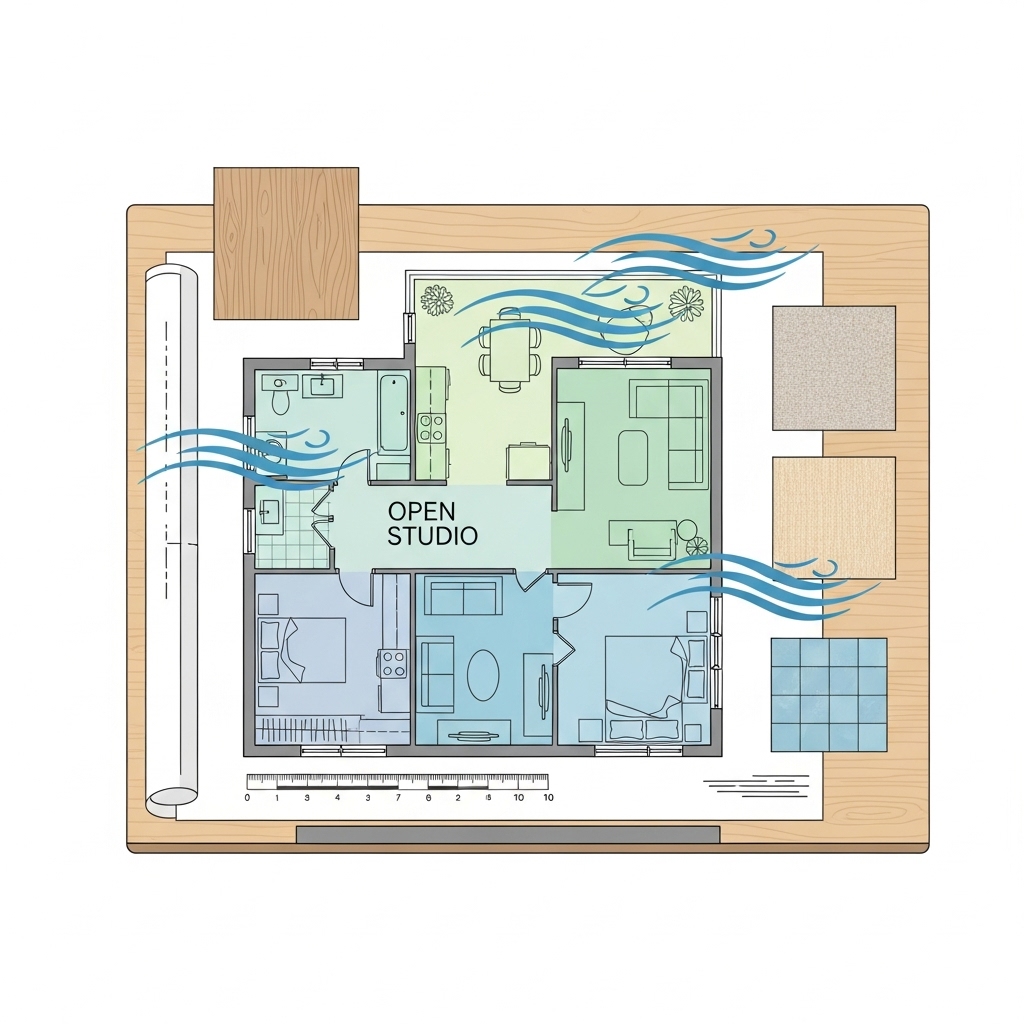Coastal lots in Huntington Beach offer sun, breeze, and a unique architectural rhythm, but they also bring constraints that shape how an ADU should be planned. Salt air, coastal winds, and smaller yards mean your floor plan must make every square foot perform. This guide explores plan types that thrive by the ocean—studio conversions, one-bedroom over-garage units, compact two-bedroom cottages, and alley-facing designs—plus tips for daylight, privacy, storage, and durable materials. In the first steps, align your objectives—guest suite, long-term rental, multigenerational living—with a site-responsive layout and, if needed, partner with a coastal-savvy coastal ADU team that understands local zoning and the coastal zone’s extra guardrails.
Start with the Site: Wind, Sun, and Neighbors
Nail the fundamentals before sketching walls. Identify prevailing winds, shade patterns from neighboring homes, and any easements or utility runs that pinch your buildable area. In Huntington Beach, coastal breezes often favor cross-ventilation strategies: align windows on opposite walls, position operable clerestories high on the leeward side, and use protected courtyards to temper gusts while preserving light and privacy.
- Solar orientation: Place primary glazing to the south where feasible, with shading devices to limit summer heat gain.
- Privacy first: Avoid placing living room windows directly facing a neighbor’s backyard; consider offset windows, frosted glass near fences, and landscape screens.
- Noise buffers: Put closets, bathrooms, or storage walls along property lines to create acoustic separation.
Studio Conversions: The Art of the Single Room
Studio ADUs created from garages or accessory structures can be generous when planned with zones. Distinguish sleeping, living, and dining areas using furniture placement and ceiling changes. A compact kitchen with a single run and a peninsula doubles as prep space and a dining counter. Pocket doors at the bathroom save swing space; mirrored closets expand the sense of volume.
- Built-ins: A full-height pantry next to the fridge carries the storage load and frees counter space.
- Murphy bed or daybed: Sleep at night, lounge by day—flex furniture stretches utility.
- Light layers: Skylights and clerestory windows bring daylight deep into the plan without sacrificing privacy.
One-Bedroom Over Garage: Elevated Views and Breezes
Second-story ADUs over garages maximize small footprints and capture breezes. Locate the stair along a side yard to minimize visual impact. Inside, a linear kitchen wall opposite a dining nook keeps circulation clear. Bedrooms benefit from corner windows; baths share a wet wall with the kitchen to simplify plumbing. Provide a small deck set back from property lines for morning sun without neighborly overlap.
- Entry strategy: Consider an exterior stair with landing lighting and a weather-protected door under an overhang.
- Storage: Use the volume over the stair for a linen cabinet or mechanical closet.
- Noise control: Use resilient channels in the garage ceiling and sealed doors to manage sound transfer.
Compact Two-Bedroom Cottage: Family-Ready Layouts
For multigenerational living or long-term rentals, a two-bedroom layout delivers flexibility. An open great room with L-shaped kitchen minimizes circulation waste. Stack the bathroom and laundry along a shared wall to shorten utility runs. If privacy is a priority, separate the bedrooms across the living space and include a small entry alcove to avoid opening directly into the living room.
- Kitchen efficiency: Standard cabinet sizes and a single window over the sink keep costs predictable.
- Smart bedrooms: Built-in wardrobes reduce the need for bulky furniture and keep clearances generous.
- Outdoor link: A 6- to 8-foot sliding door to a small terrace extends the living area without expanding the footprint.
Alley-Facing ADUs: Make the Most of Back-Lot Access
Alley access is common near the coast and offers design opportunities. Orient front doors and parking to the alley to relieve the main street frontage. With thoughtful lighting and fencing, alleys become functional address points. Use windows that peer toward the alley or inward to a small courtyard, preserving privacy for the primary home and neighbors alike.
Plan Patterns that Fit Coastal Lots
- L-shaped courtyard plan: Wrap living areas around a small patio that shields wind and frames sky views.
- Shotgun plan with side yard windows: A long, narrow design with windows on one side captures light while respecting setbacks.
- Split-volume design: Offset roof forms create clerestory opportunities and visual variety while keeping height within limits.
Materials and Systems for Salt Air
Coastal conditions reward durable choices. Use fiber-cement or treated wood claddings, high-quality flashing, and stainless or coated fasteners. Specify exterior-grade door hardware and consider anodized aluminum or fiberglass windows. Ventilated rainscreens can protect sheathing and extend the life of the envelope. Inside, choose materials that tolerate humidity swings and clean easily after enthusiastic beach days.
Storage Without the Bulk
Storage makes small plans livable. Tuck built-in benches under windows, add a full-height cabinet beside the fridge, and consider a laundry tower with overhead shelving. In studios, use a floor-to-ceiling cabinet wall that doubles as sound buffer to a neighboring property line. In two-bedroom plans, create a shallow, continuous storage zone along a hallway to hold linens, cleaning tools, and seasonal items.
Daylight, Ventilation, and Energy Code Tips
California’s energy code encourages efficient envelopes and right-sized glazing. Distribute windows across orientations and emphasize high-performance glazing on larger openings. Cross-ventilation is essential in coastal climates; use operable windows on opposing walls or pair a patio door with awnings on the opposite side. A balanced mechanical ventilation system complements natural breezes on still days and improves indoor air quality year-round.
Setbacks, Height, and Fit
State law protects an 800-square-foot ADU with four-foot side and rear setbacks and at least 16 feet of height. Many coastal lots can accommodate that envelope, even when primary homes are compact. Where taller forms are allowed, second-story units can respect neighbors by stepping back upper walls and orienting windows toward alleys or courtyards. In conversions, leverage existing walls to maintain nonconforming setbacks while upgrading structure and moisture control.
Outdoor Rooms that Work Near the Ocean
Outdoor living is the secret weapon of small ADUs. A modest deck, wind-screened patio, or narrow side yard with bench seating can expand daily life. Use exterior lighting that is neighbor-friendly, shielded, and on dimmers. Choose plantings that manage wind and salt while maintaining visibility and safety along alleys.
Mid-Project Design Checks
As drawings progress, run a checklist: Does the plan minimize corridor space? Are windows placed to avoid direct views into neighbors’ yards? Do the kitchen and bath share a wet wall? Are there at least two operable windows in the main living area for cross-ventilation? Is the mechanical equipment in a location that works for maintenance and acoustics?
At mid-design, revisit layout options if site discoveries arise—such as a utility easement or a heritage tree. If you need to pivot to a different plan type, keep the structural grid and window package as standardized as possible to avoid new lead times. When you are working with a professional, ask for an itemized response to each zoning and building code requirement to reduce plan check comments. If you need guidance aligning layout, structure, and energy choices, reach out to a seasoned accessory dwelling unit partner that understands Huntington Beach’s coastal context.
Frequently Asked Questions
Q: Which floor plan is best for rental flexibility? A: One-bedroom and compact two-bedroom plans are versatile, serving couples, small families, and visiting relatives. Studios work well for guest suites or home offices and can still rent well when designed with strong storage and sleeping zones.
Q: Can I build a second-story ADU on a coastal lot? A: In many cases, yes, subject to height limits, setbacks, and design standards. Consider step-backs, window placement, and deck locations to preserve privacy and limit bulk near property lines.
Q: How do I protect materials from salt air? A: Specify corrosion-resistant fasteners and hardware, breathable building wraps, and robust flashing at all penetrations. Consider rainscreen assemblies to extend cladding life.
Q: Do alley-facing entries cause security issues? A: Thoughtful lighting, fencing, and clear addressing typically resolve concerns. Many coastal neighborhoods successfully use alleys as secondary frontages.
Q: What if my lot is very narrow? A: Shotgun or side-corridor plans with windows focused on one side yard are effective. Pocket doors, built-ins, and a continuous floor finish keep narrow spaces feeling open.
Ready to Shape a Coastal-Ready ADU?
Your best floor plan is the one that fits your lot’s microclimate, respects neighbors, and lives larger than its footprint. Start with the site, select a plan type that suits your goals, and refine details that stand up to salt air. When you are ready to advance from concepts to permit-ready drawings, coordinate architecture, structure, and energy early to keep reviews smooth. For a cohesive process from layout to construction in Huntington Beach, collaborate with a coastal-experienced ADU design partner who can bring your vision to life with durability and comfort at the forefront.

